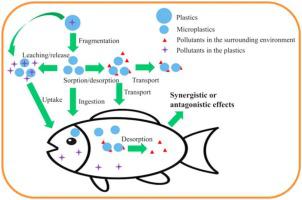Journal of Hazardous Materials ( IF 13.6 ) Pub Date : 2021-11-26 , DOI: 10.1016/j.jhazmat.2021.127908 Tengda Ding 1 , Liyan Wei 1 , Zhangming Hou 1 , Juying Li 1 , Chunlong Zhang 2 , Daohui Lin 3

|
Microplastics (MPs) have received an increasing attention because of their ubiquitous presence and aquatic toxicity associated with MPs and MP-bound contaminants in the natural water. This review is to critically examine the chemical additives leached from MPs, the altered contaminant behaviors and the resulting changes in their aquatic ecotoxicity. Available data suggest that heavy metals Zn, Cr, Pb, and Cd regulated and present in plastics at the sub-mg g-1 to mg g-1 level can leach a significant amount depending on MPs size, aging, pH, and salinity conditions. MP-bound organic contaminants are primarily additive-derived (e.g., brominated diphenyl ethers, nonylphenol, and bisphenol A) at the µg g-1 to mg g-1 level, and secondarily pyrogenic and legacy origins (e.g., PAHs and PCBs) in the range of ng g-1 and mg g-1. MPs tend to have higher but more variable sorption capacities for organic compounds than metals (1.77 ± 2.34 vs. 0.82 ± 0.94 mg g-1). MPs alter the behavior of heavy metals through the electrostatic interactions and surface complexation, while the transport of additive derived organic compounds are altered primarily through hydrophobic effect as supported by a positive correlation (R2 = 0.71) between the logarithmic MPs-adsorbed concentrations and octanol/water partition coefficients (KOW) of organic compounds. MPs constitute less than 0.01% of the total mass of aquatic particulates in typical waters, but play a discernible role in the local partitioning and long-distance movement of contaminants. MPs alone exert higher toxicity to invertebrates than algae; however, when MPs co-occur with pollutants, both synergistic and antagonistic toxicities are observed depending mainly on the ingestibility of MPs, the extent of sorption, MPs as a transport vector or a sink to scavenge pollutants. We finally suggest several key areas of future research directions and needed data concerning the role of MPs in mitigating pollutant leaching, transport and risk under conditions mimicking natural and polluted waters.
中文翻译:

微塑料改变了天然水中的污染物行为和毒性
微塑料 (MPs) 因其无处不在的存在以及与天然水中 MP 和 MP 结合污染物相关的水生毒性而受到越来越多的关注。这篇综述旨在批判性地检查从 MPs 中浸出的化学添加剂、改变的污染物行为以及由此产生的水生生态毒性变化。现有数据表明,根据 MPs 尺寸、老化、pH 值和盐度条件,塑料中以亚 mg g -1至 mg g -1水平调节和存在的重金属 Zn、Cr、Pb 和 Cd可以大量浸出. MP 结合的有机污染物主要是添加剂衍生的(例如溴化二苯醚、壬基酚和双酚 A),浓度为 µg g -1至 mg g -1水平,其次是在 ng g -1和 mg g -1范围内的热源和遗留来源(例如,多环芳烃和多氯联苯) 。MPs 对有机化合物的吸附容量往往比金属更高,但变化更大(1.77 ± 2.34 对 0.82 ± 0.94 mg g -1)。MPs 通过静电相互作用和表面络合改变重金属的行为,而添加剂衍生的有机化合物的传输主要通过疏水效应改变,这得到对数 MPs 吸附浓度和辛醇之间的正相关 (R 2 = 0.71) 的支持/水分配系数(K OW) 的有机化合物。MPs在典型水域中占水生颗粒物总质量的不到0.01%,但在污染物的局部分区和长距离移动中发挥着明显的作用。单独的 MPs 对无脊椎动物的毒性高于藻类;然而,当 MPs 与污染物共存时,观察到的协同毒性和拮抗毒性主要取决于 MPs 的可摄入性、吸附程度、MPs 作为运输载体或清除污染物的汇。最后,我们提出了未来研究方向的几个关键领域,以及在模拟天然和污染水体的条件下,关于 MPs 在减轻污染物浸出、运输和风险方面的作用所需的数据。



























 京公网安备 11010802027423号
京公网安备 11010802027423号